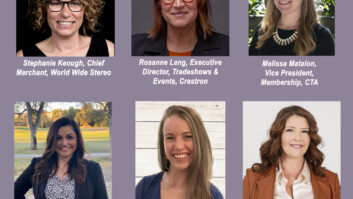Helping Architects Become Your Best Sales people
Having a solid working relationship with an architect is a great idea for several reasons. First, architects are among the first team members brought onto any project. If the architects that you work with understand the benefits of engaging an electronics consulting firm early in the process, then you will have a chance for your voice to be heard while the project is still being sketched out. While this still doesn’t guarantee that anyone will listen, at least you will be able to say, “I told you so” after the fact.
Being involved in the design process gives you the opportunity to secure enough square footage for your racks and panels in locations that make sense. It also gives you the opportunity to advise on cabinet sizes, display locations, room layout, and even sound isolation.
GETTING INVOLVED EARLY

If the architects that you work with understand the benefits of engaging an electronics consulting firm early in the process, then you will have a chance for your voice to be heard while the project is still being sketched out. Getting involved late in the process either means that you’ll have to negotiate with the client, interior designer, and architect to have the blueprints revised (which is costly and time-consuming), or you will have to deal with the limitations, making the project more difficult for you and probably more expensive for the client. Getting in early, however, gives you the opportunity to claim a bigger piece of the project’s budget. If your firm isn’t involved in the design process, then there’s a very good chance that the client has already committed to spend three times the original budget and is looking to reign in the spending by the time you’re finally contacted. An underfunded project is no fun for anyone.
Second, once an architect has been selected, clients tend to rely on the architect to guide them through the process, making the architect their trusted advisor for the project. Being referred by the architect gives you a head start in gaining the client’s trust and respect and makes them more receptive to your suggestions. If word spreads among the project team members that you’ve earned the trust of the architect, then they may be more likely to ask you to look at some of the other projects they’re working on.
Third, architects pre-qualify clients for you. Not all projects have architects, but those that do tend to also have larger budgets and clients who are dedicated to completing them. If the architect understands the value that your firm brings to a project, he or she will be selling your services to the client even before your first client meeting.
CONTACTING AN ARCHITECT
The most effective way to develop a relationship with an architect is to work with them on a project and make a favorable impression. Once you’ve proven to them that you’re reliable and that you meet deadlines and stay within budget, they will be much more receptive to your suggestions. However, even if you are marketing to architects that you have never worked with, the process described below will help you get your proverbial foot in the door.
First, demonstrate your potential value to them. Prepare a flyer, brochure, or DVD introducing them to your firm and detailing the services that you provide. This marketing material should be targeted at architects. In other words, this shouldn’t be the same brochure that you give potential clients. Instead, it should speak directly to an architect’s concerns and should clearly and succinctly describe how you can make their lives easier and make them look better in the eyes of their clients (architects appreciate referrals, too). The marketing material should also detail your process and how you typically work with architects and other team members. For extra credit, include information that will help an architect integrate technology into their future projects. The more substantive your offering is, the more likely it will be read and kept for future reference, rather than being tossed into the circular file cabinet.
Second, if you haven’t worked with the architect before, offer to show them your work. Along with the marketing materials, give them a set of prints for your showroom or a recent project and offer to show them the project, as well. If the architect agrees to a site visit, then be sure to tie the physical project to the as-built prints—architects like to see that the project was well-documented and built according to specifications.
Third, offer to teach them something. CEDIA has a great Industry Outreach program, whose goal is to raise awareness of our industry among industry partners, including architects, builders, and interior designers. Becoming certified by CEDIA as a Registered Outreach Instructor (“ROI”) allows you to offer hour-long classes that have been registered with the American Institute of Architects (“AIA”) for continuing education credit. To maintain their license, architects are required to meet continuing education requirements in a variety of categories, as defined by their state’s licensing board (for more details and information on your local AIA chapter, see www.aia.org).
In addition to being registered with the AIA, the ROI courses currently available are also approved for continuing education credit for members of the American Institute of Build Design (“AIBD”), the American Society of Interior Designers (“ASID”), the International Interior Design Association (“IIDA”), the Interior Design Continuing Education Council (“IDEC”) and the Interior Designers of Canada (“IDC”). Becoming a Registered Outreach Instructor gives you a reason to visit industry partners in your area to offer classes that will be of value to them. And presenting the classes effectively establishes you as an authority in the field. Given the recent decrease in new housing starts, architects are likely to be even more receptive to increasing their knowledge (or at least in fulfilling their continuing education requirements during a lull in their workload).
To become an ROI, you will have to attend CEDIA’s ROI “Train the Trainer” course, offered at various times throughout the year, either at CEDIA headquarters in Indianapolis or in conjunction with events, such as CEDIA EXPO in September. For more information, visit www.cedia.org/ outreach/registered_instructors.
Finally, learn something about architecture. You can join your local AIA chapter as an associate member and sign up for their mailing list (again, see www.aia.org for more information). If the chapter is active, then they may have several meetings and social events each month. Take the time to go to a few of these events and learn something about the architects and the architecture in your area. AIA social events offer a great opportunity to meet local architects in a casual environment.
Brad Gibbs is the president of Peak-to-Peak Systems Inc., an electronics systems design and integration firm in the San Francisco Bay Area.







